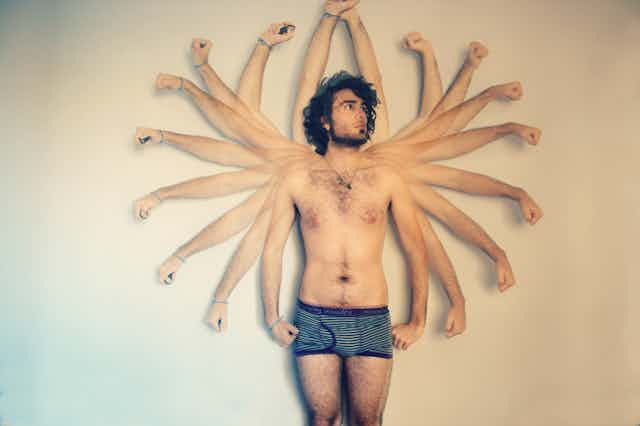Many amputees experience pain in their missing limbs, but allowing them to “see” their missing limbs in action through augmented reality technology may help alleviate this phantom limb pain (PLP), a case study published today has found.
Amputees feel PLP in the location of their missing limbs. A 1984 survey of American veterans with amputations found 78% of respondents reported phantom pain. Of those receiving treatment, only 1% reported lasting benefits from any treatment.
Today’s paper, published in Frontiers in Neuroscience, found a chronic PLP sufferer had significantly reduced pain after using a virtual arm in augmented reality.
James McAuley from Neuroscience Research Australia said: “This publication reports a very interesting case of long standing PLP with what appears to be a very impressive outcome, which is not common in the pain sciences.”
In the past, treatment of PLP has involved drugs, spinal cord stimulation, vibration therapy, acupuncture, hypnosis and biofeedback. Unfortunately, most treatment approaches do not result in consistent symptom improvement.
Virtually pain free
Lead researcher Max Ortiz Catalan, from Chalmers University of Technology, Sweden, has developed a new treatment for PLP using augmented reality. Augmented reality is where a computer-generated image is superimposed on a user’s view of the real world.
With Mr Ortiz Catalan’s treatment, electrodes on the patient’s stump detect electrical signals in the muscles, which are then translated into arm movements. The patient sees himself on a screen with a superimposed virtual arm, which he controls in real time.
Virtual reality treatments in the past have used mirror therapy to reflect the opposite limb – limiting treatment to patients with only one-sided amputations.
“In our case, the control comes directly from the amputated limb through myoelectric pattern recognition, so the patient really needs to execute their motor intention to make things happen,” Mr Ortiz Catalan said.
There’s also a gaming component to the treatment, where patients control a racing game with the movements of their phantom limb.
“The idea is to promote motor execution in the missing limb,” Mr Ortiz Catalan said. “We have also designed a home training system so the patients can take it home in the future. I say in the future because this treatment needs to prove its benefits first.”
Mr Ortiz Catalan suggests the pain relief may be due to a combination of factors. These include reactivating the motor areas of the patient’s brain (which would ordinarily move the missing limb) and the patient’s visual feedback, which tricks the brain into believing the limb is executing the motor commands.
Testing the reality
The patient in the case study for the treatment lost his arm just below the elbow in 1965. He had been suffering moderate to unbearable pain since that time, never being entirely pain free. Following a period of the treatment, the patient now experiences periods where he is completely pain-free.
The perceived posture of the patient’s phantom limb was also affected. He had initially reported his phantom arm posture as a “strongly closed fist”, but following treatment it gradually relaxed to the neutral posture displayed by the virtual limb. He also learnt to control the moment of his phantom hand when not connected to the treatment system.
Dr McAuley said these preliminary findings are very impressive: “The authors appear to have conducted and reported on a scientifically rigorous case study and their conclusions seem appropriate in that they haven’t gone ‘beyond the data’.
"These new directions focus on the brain, and have in common some sort of sensorimotor re-learning/re-training. Applying these principles across other pain conditions, particularly common conditions such as low back pain, holds significant promise.”
Rene Van Meeuwen, from the University of Western Australia, said this treatment could be extended in the future with the development of Google Glass: “It will be the ultimate device for any amputee whereby the patient, and anyone else with a pair of Google Glass, will find the amputation itself will disappear.”
Mr Van Meeuwen also suggested future links with devices such as Tan Le’s head set, which reads its user’s brainwaves, making it possible to control virtual objects.
Mr Ortiz Catalan said the next step is to test this treatment on a wider population of patients suffering from PLP.
“We’re willing to provide this system to any researcher or physiotherapist interested in evaluating its use for PLP,” he said. “If it turns out to be useful for all patients, then hopefully it will spread as a standard treatment.”

